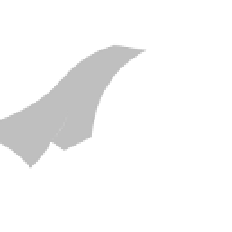Geology Reference
In-Depth Information
Extensional
Structures
half graben
master normal
fault
antithetic
fault
synthetic
fault
basin
fill
horst
back-
tilting
graben
hanging wall
footwall
Fig. 4.22
Schematic of cross-section of normal faults in an extensional regime.
The master fault delineates footwall and hanging-wall blocks. A broad half-graben is cut by synthetic and antithetic
faults. Note both the geometry of the syntectonic growth strata that fill the faulted basins and the curvature of the
hanging wall toward the master fault (hanging-wall roll-over).
Interbasin Transfer Zones
Antithetic interbasin
Antithetic interference
zone
up
up
ridge
down
down
extension
direction
complex
polygonal
transfer
zone
down
down
relay
ramp
up
1 km
up
0
A
B
Structures in a
Continental Rift
Synthetic relay
ramp
up
up
Transfer
fault
Lake
Bogoria
down
down
up
down
Fig. 4.24
Schematic fault geometry in the East
African Rift system.
Relay ramps, transfer faults, and smaller-scale synthetic
faults facilitate transfer of displacement between the
major faults. Note that, for any cross-section
perpendicular to the traces of the major faults, the net
displacement across the region is nearly equal, despite
large along-strike differences in displacement on
individual faults. Modified after Morley (1989).
up
down
C
D
Fig. 4.23
Interbasin transfer zones.
Simplified geometries of structures that assist the
transfer of deformation between two regional-scale,
overlapping or non-overlapping normal faults. Modified
after Gawthorpe and Hurst (1993).
(iv)
antithetic interbasinal ridges
, which develop
where normal faults change polarity and step
into the footwall. Each of these structures pro-
vides a mechanism whereby the total regional
displacement can vary smoothly along strike,
despite the fact that individual faults die out, that
displacement is variable along each fault, and
that both fault lengths and amount of overlap
change through time. Any relatively broad region
that is undergoing extension will display some of
these displacement-accommodation features. For
example, during much of Cenozoic time, active
extension has been occurring across eastern
Africa. As a consequence, an elaborate network
of mature normal faults has developed. Within
many segments of the East African Rift,
en
echelon
normal faults joined by relay ramps and
complex transfer zones (Fig. 4.24) exemplify the
spatially varied distribution of faults and strain
that accommodates crustal extension. Where
Quaternary strain within complexly faulted rifts
has been particularly well quantified, such as in
the Taupo Rift on the North Island of New
Zealand (Nicol
et al.
, 2006), both the compensa-
tion that occurs between different subregions
that slip at changing local rates through time and































































































































































































































































